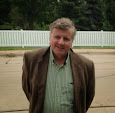In Chapter Nine of Philip K. Dick's
We Can Build You, Sam Barrows dismisses the Lincoln simulacrum's desire to "speechify" as nothing but "the familiar mechanical man gimmick, with this dressed-up historical guise. The same thing was demonstrated at the 1939 San Francisco World's Fair, Pedro the Vodor." A true Cartesian, Barrows distinguishes the human from the animal (which Descartes metaphorically likened to the machine) by the human capacity for language. The Lincoln simulacrum is, in effect, dismissed by Barrows as being as mindless as a parrot imitating human speech.
I suspect Philip Dick was writing from memory, as he (or the book's editor) has made a minor orthographic error, for it's actually spelled voder, not vodor. In all likelihood Dick visited the San Francisco World's Fair (formally, the
Golden Gate International Exposition, held 1939 - 1940) and saw, at around the age of 11, Bell Laboratories' demonstration of what he (mis)remembered as "Pedro the Vodor" (pictured above, with operator; Bell's voder exhibit is to the right). Developed by Bell engineer H. W. Dudley, the voder was Bell Laboratories' first demonstration of an electronic speech synthesis device. This early analog system preceded Bell Labs' work in "articulatory synthesis" conducted by Cecil Coker in the 1960s, and Joe Olive's later work on "concatenate synthesis" in the 1970s (see Mark Tatham and Katherine Morton,
Developments in Speech Synthesis, Wiley 2005). I mention this later research in speech synthesis by Bell Labs because it is worth mentioning that a famous milestone in that research was a sample created by John L. Kelly in 1962 using an IBM 704 computer, consisting of Kelly's vocoder synthesizer recreating "A Bicycle Built for Two" (AKA "Daisy Bell"). Arthur C. Clarke, then visiting his friend John Pierce at the Bell Labs' Murray Hill facility, witnessed the demonstration and later used it in
2001: A Space Odyssey during the scene when the HAL 9000 computer is being dismantled by Dave Bowman. (I recommend the essay by Joe Olive, recognized as one of the leading experts in text-to-speech [TTS] synthesis, titled "'The Talking Computer': Text to Speech Synthesis," in David G. Stork, Ed.,
HAL's Legacy: 2001's Computer as Dream and Reality, MIT Press 1997).
Note that the voder is an electrical speech
synthesizer while the vocoder is a speech
analyzer coupled with a voder speech synthesizer. Dennis Klatt has posted
a historical review of the development of speech synthesizers and has also conveniently posted a short sample of the sound of the voder (which Philip K. Dick undoubtedly heard) which you can hear by clicking this
link. For those interested, I note that Wendy Carlos' music for the film Stanley Kubrick made after
2001,
A Clockwork Orange, is the earliest work in her
ouevre to use the vocodor, but she indicates
here that the vocoded portions were done prior to being assigned the film, those vocoded portions being the last movement of Beethoven's
Symphony #9 and
Timesteps.






